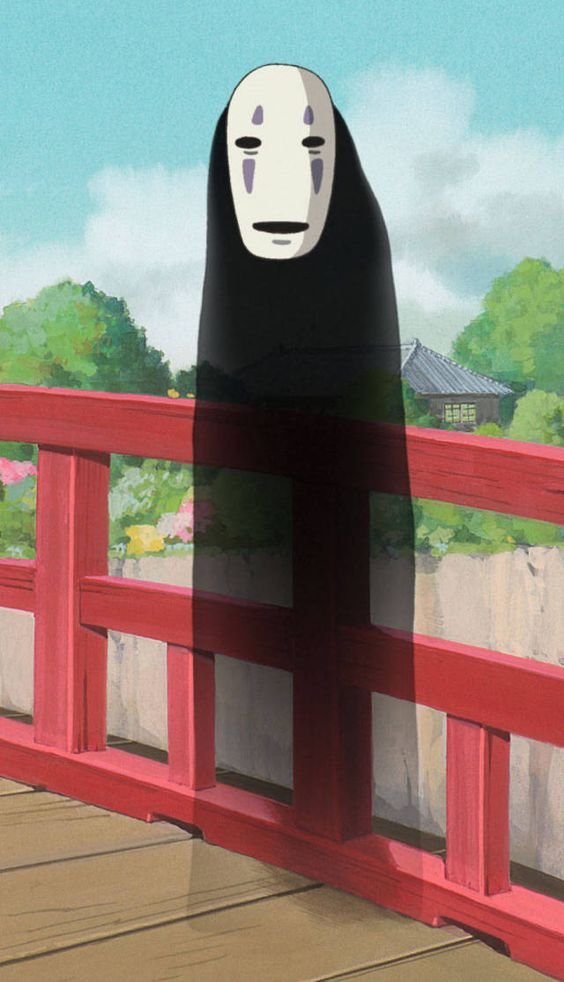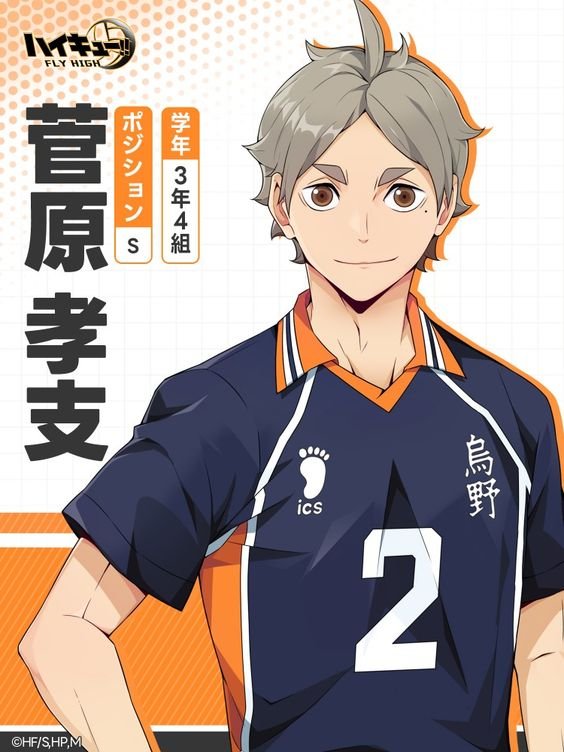
No-Face
No-Face |
|
|---|---|
 |
|
| Japanese Name: | 顔無し |
| Rōmaji: | Kaonashi |
| Race: | Spirit, “Monster” by Yubaba |
| Age: | 60 years |
| Gender: | Female |
| First Appearance: | Spirited Away |
| Voice actor (Japanese): | Akio Nakamura |
| Voice actor (Disney): | Bob Bergen |
Appearance

No-Face full appearance.
Upon his first appearance, No-Face has an ethereal, semi-transparent form, flickering in and out of sight. His inner organs are partially visible, rhythmically pulsing in various states. His overall shape resembles a long, black, tube-like figure. While it’s unclear if he has a fully physical body, No-Face is shown to form limbs—arms and legs—that leave visible footprints as he moves. His “face” is marked by a haunting, blank mask with muted grey-violet accents. Though the mask has a painted mouth, No-Face conceals his true, much larger mouth behind it, hidden with remarkable skill.
Personality
No-Face is a solitary spirit drawn to Chihiro Ogino, intrigued by her genuine and kind-hearted nature. Initially, he communicates through simple grunts and moans rather than spoken words. Unfamiliar with the Bathhouse’s workings or the spirits within it, No-Face learns by observation, mimicking behaviors to adapt to his surroundings.
Influenced by the greed and moral decay of the Bathhouse workers, No-Face begins to embody their traits, hoping that by mirroring those around Chihiro, he might win her approval. Ironically, this approach has the opposite effect, though Chihiro continues to show kindness to him, accepting his help at various points and even inviting him to accompany her.
His attachment to Chihiro grows into an intense fixation, and he becomes volatile after ingesting a River Spirit’s emetic dumpling, which Chihiro gives him. Though distressed and aggressive, he responds to Chihiro’s calls, eventually calming and joining her as she travels by train to Swamp Bottom. Outside of the Bathhouse’s influence, he returns to a gentler state, obediently following Chihiro’s instructions, such as “sit” and “behave yourself.”
In his monstrous, uncontrolled form, No-Face adopts the worst qualities of those he has consumed—especially Aogaeru’s—becoming loud, arrogant, and selfish. His obsession with Chihiro grows disruptive, affecting everyone around him.
Toward the film’s end, No-Face meets Zeniba, a witch who lives simply and works independently, unlike Yubaba, who governs the Bathhouse with a strict hierarchy. Embracing the more peaceful, industrious environment, No-Face adapts again, taking up spinning and knitting, displaying unexpected skill. He seems content in his new role and willingly accepts Zeniba’s offer to stay as her apprentice, finding a place where he truly fits.
History
No-Face first appears standing silently on a bridge, watching Chihiro and Haku as they hurriedly pass, intent on hiding Chihiro’s human identity from other spirits. Later, he reappears on the bridge the following morning, captivated by Chihiro as she walks by. Concerned about him waiting in the rain, Chihiro later lets No-Face into the Bathhouse. Grateful, he appears beside the Foreman, stealthily securing a Bath Token for her. When Chihiro thanks him, he eagerly fetches more tokens, but she gently declines, stating she only needed one. Disheartened, No-Face vanishes, dropping the tokens in disappointment.
Later, as the workers celebrate the departure of the unnamed River Spirit, No-Face observes from a corner, noticing their fierce scramble for scattered gold. Learning that gold is valued, he lures the unsuspecting spirit Aogaeru to him by flaunting gold, then swallows the frog spirit, absorbing his corruptive traits. With Aogaeru’s qualities affecting him, No-Face begins to demand luxury, tossing conjured gold to the workers and enlarging himself by consuming vast amounts of food.
No-Face’s newfound “wealth” makes him an object of fascination, with workers continually approaching him in hopes of receiving tips. However, when Chihiro turns down his gift of gold, he drops it to the ground in dismay, sparking a frenzy among the greedy workers. Enraged by a perceived insult from one of them, he consumes two more workers, revealing his darker side to the horrified onlookers.

The iconic train scene featuring Chihiro and No-Face.
Distressed, he retreats to a guest room and demands to see Chihiro. Despite his offerings, she refuses his gold, instead telling him he cannot provide “what she truly wants.” In sorrow, No-Face eats the last piece of the emetic dumpling given to Chihiro by the River Spirit. This sets off a transformation as he pursues Chihiro through the Bathhouse’s lower levels, vomiting everything he had consumed along the way. Gradually, he returns to his gentler self, accompanying Chihiro to the train platform as they journey to Zeniba’s home at Swamp Bottom to return a stolen sigil.
As they part, Zeniba invites No-Face to stay with her. In his final appearance, he is seen alongside Zeniba and her Hopping Lantern, bidding Chihiro farewell as she departs with Haku.
Abilities
Mimicry: No-Face can adopt the voice and behaviors of any creature he consumes. For instance, after swallowing Aogaeru, he not only speaks in Aogaeru’s voice but also mimics his frog-like jumping and adopts parts of his personality. If No-Face ingests multiple creatures, he can blend their voices, sometimes speaking in several tones at once. Because he only speaks after consuming another being, his true voice—and even his gender—remain ambiguous.
Alchemy: No-Face has the unique ability to turn mud and dirt into valuable items, such as gold.
Absorption: His appetite extends beyond food; he can consume both material objects and spirits alike. This ability may be an extension of his mimicry power, allowing him to absorb and reflect the qualities of those he ingests.
Projectile Vomiting: No-Face can expel his consumed contents with force, targeting distant enemies, as demonstrated during his confrontation with Yubaba.
Behind the Scenes

The original illustration for No-Face’s character.
No-Face is an original character conceived by Hayao Miyazaki, who did not exist in traditional Japanese mythology. During a press conference in July 2001 at the Imperial Hotel, following the film’s completion, Miyazaki shared insights about No-Face’s role, stating, “When I’m not around, the producer has been telling everyone, ‘No-Face is Miya-san’s alter ego.’ While that may hold some intellectual merit, I believe there’s a bit of No-Face in all of us.”
He elaborated further, explaining, “There are No-Faces all around us. The distinction between evil spirits and deities is often paper-thin. Moreover, this story unfolds in Aburaya, a bathhouse. Once you open its doors, a variety of things can come through.” However, when questioned about whether No-Face symbolizes contemporary youth, he clarified, “I didn’t create this film with that intention. No-Face is merely a name and a mask; beyond that, his thoughts and desires remain a mystery. We chose the name No-Face because his expression is unchanging; that’s the essence of his character. Yet, I do believe there are individuals like him everywhere—those who cling to others while lacking a strong sense of self.”
Design
No-Face’s design draws inspiration from the Bombyx mori, or silkworm. Character designer Masashi Ando noted, “Though No-Face is largely expressionless, I included a slight hint of emotion. It might have been more effective to make his mask completely Noh-like, devoid of expression, allowing lighting to convey his feelings. No-Face consumes the Bathhouse workers, and I thought it would be intriguing if he absorbed their personalities and reasoning abilities, thus becoming more human and relatable.”
Hiromasa Yonebayashi is also credited as a model for No-Face’s design.